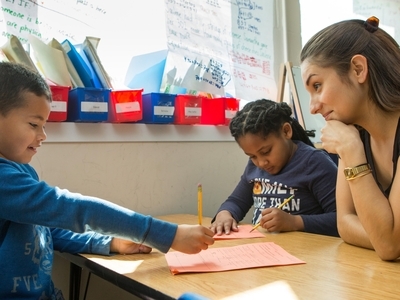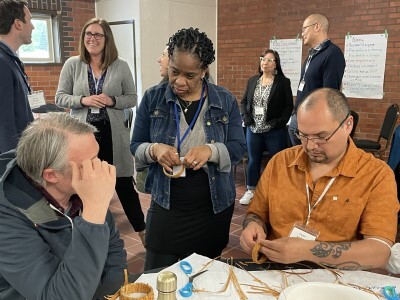Personalized Learning’s Weakest Link?
Topics

Next generation learning is all about everyone in the system—from students through teachers to policymakers—taking charge of their own learning, development, and work. That doesn’t happen by forcing change through mandates and compliance. It happens by creating the environment and the equity of opportunity for everyone in the system to do their best possible work.
In the push for next gen learning, NGLC director Andy Calkins says the biggest challenge is effective change management.
This post originally appeared on the Center for Reinventing Public Education's blog on August 8, 2018.
Much of the work going on nationally to study and build the evidence base for personalized, student-driven learning focuses on changes in traditional metrics – scores on state standards-based tests and on similar forms of academic assessment, such as NWEA’s MAP tests. This is valid and worthwhile, but it is not the whole story.
In fact, to our minds at Next Generation Learning Challenges (NGLC), it may not be the most important part of the story.
In its most robust definitions, next gen learning—personalized, competency-based, experiential, student-driven—reflects much deeper, richer, and broader goals than simply increasing proficiency rates on state math and ELA exams. Achieving those goals for all students and communities necessitates the development of an evidence base that is similarly deep, rich, and broad.
That means focusing on two additional dimensions, beyond 1) progress in academic skills measured in traditional ways:
- Building evidence for next gen learning’s impact on life skills – the creative know-how, habits of success, and wayfinding abilities that today’s students must develop in order to thrive in a world of rapid and accelerating change
- Building evidence around effective change management for personalized learning – the ways that exemplary districts, schools and communities are successfully navigating the historically daunting path to genuine transformation
These additional two dimensions are linked, as transforming schools and districts all must seek ways to measure and demonstrate student growth in life skills in order to make their case for disruptive transformation (i.e., taking a different reform tack than doubling-down on acing the state tests with yet more test prep). NGLC and our national school-design grantees and partners are and have been active contributors to the design-build around the second additional dimension, measuring what matters most (see “How Next Generation Schools Define Success” and “Measures That Matter Most” as well as our Assessment for Learning Project).

But over the past year, we have developed a deep conviction that the third dimension—the transformation process itself—is the least understood, most challenging of them all, and is the dimension most likely to emerge as the weakest link in the entire personalized, student-centered, next gen learning movement.
For evidence on that point, look no further than the report issued just last month by the Center for Reinventing Public Education (CRPE), “Personalized Learning at a Crossroads.” CRPE’s researchers spent two years intensively visiting, interviewing, and surveying educators at the Bill & Melinda Gates Foundation’s two foremost networks of personalized learning—the Next Gen Systems Initiative (six medium to large districts) and the NGLC Regional Funds (at the time of the study, six metro or state-based intermediary organizations working closely with districts).
Their conclusion: generally, schools participating in these initiatives—particularly district schools, more so than charters—were unsuccessful at innovating vigorously towards personalized learning “within systems and conditions that were not designed to support innovation.” The changed practices they observed were generally transactional and incremental, failing to reflect the deeper ideas about whole-child development, 21st-century outcomes, and next gen learning strategies that are at the root of the whole enterprise.
The CRPE report points up many of the things that we’ve all learned about this work and what it requires:
- The importance of going deeply into the Why and the What of all of this before advancing into the How, so teachers own the entire vision and goal-set for this transformation of their practice and aren’t simply executing out of compliance (for more on this, see NGLC’s MyWays project, aimed at addressing that point head on)
- The crucial role of high-quality, extensive, on-going, professional learning for teachers and school leaders, using approaches that reflect the same learning principles at the root of personalized, next gen learning for students
- Strong school leadership and committed district support, including running interference on operating conditions that create obstacles to successful implementation
- Understanding the vital importance of skillful change management for reforms of this nature.
Taken in that light, the CRPE report stands as an important milestone in this movement—a data-supported indicator and reminder of the complexity and challenge inherent in the work.
The CRPE report stands as an important milestone in this movement—a data-supported indicator and reminder of the complexity and challenge inherent in the work.
What’s needed to address this challenge? We believe that educators, reformers, policymakers, researchers and community leaders seeking to advance next gen learning need to:
- Substantially raise the visibility of the crucial importance of next gen change management—what NGLC calls “innodoption”—to the successful implementation of student-centered learning, among school and district leaders, policymakers, researchers, funders, and other influencers in the transformational end of the ed reform spectrum.
- Build a knowledge and evidence base on what emerging forms of next gen “innodoption” look like in a school reform context, including policy conditions that appear to be instrumental, and develop a set of tools and resources to support those processes.
- Deepen K-12 practitioners’ awareness and (ultimately) expand their use of innodoption processes through wide dissemination of the research and tools; codification of effective-practice indicators for continuing development of the evidence base and use by the field; and development of a set of potential next-step strategies to explicitly spur district and policymaker use of those indicators, tools, and strategy resources.
NGLC, together with a range of partners that includes several school districts seeking to transform student learning and outcomes, is preparing to launch an initiative that will take on all of these needs. Old-think change processes are the Achilles Heel that could undermine the impact of all the new and learning-science-based thinking that student-centered, next gen, personalized learning represents. In order for these forms of learning to genuinely take root, as the CRPE report very clearly illustrates, personalized learning has to walk its own talk. The journey itself needs to embody the goals.




